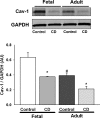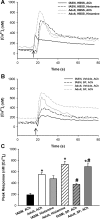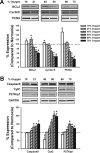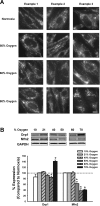Oxygen dose responsiveness of human fetal airway smooth muscle cells
- PMID: 22923637
- PMCID: PMC3469631
- DOI: 10.1152/ajplung.00037.2012
Oxygen dose responsiveness of human fetal airway smooth muscle cells
Abstract
Maintenance of blood oxygen saturation dictates supplemental oxygen administration to premature infants, but hyperoxia predisposes survivors to respiratory diseases such as asthma. Although much research has focused on oxygen effects on alveoli in the setting of bronchopulmonary dysplasia, the mechanisms by which oxygen affects airway structure or function relevant to asthma are still under investigation. We used isolated human fetal airway smooth muscle (fASM) cells from 18-20 postconceptual age lungs (canalicular stage) to examine oxygen effects on intracellular Ca(2+) ([Ca(2+)](i)) and cellular proliferation. fASM cells expressed substantial smooth muscle actin and myosin and several Ca(2+) regulatory proteins but not fibroblast or epithelial markers, profiles qualitatively comparable to adult human ASM. Fluorescence Ca(2+) imaging showed robust [Ca(2+)](i) responses to 1 μM acetylcholine (ACh) and 10 μM histamine (albeit smaller and slower than adult ASM), partly sensitive to zero extracellular Ca(2+). Compared with adult, fASM showed greater baseline proliferation. Based on this validation, we assessed fASM responses to 10% hypoxia through 90% hyperoxia and found enhanced proliferation at <60% oxygen but increased apoptosis at >60%, effects accompanied by appropriate changes in proliferative vs. apoptotic markers and enhanced mitochondrial fission at >60% oxygen. [Ca(2+)](i) responses to ACh were enhanced for <60% but blunted at >60% oxygen. These results suggest that hyperoxia has dose-dependent effects on structure and function of developing ASM, which could have consequences for airway diseases of childhood. Thus detrimental effects on ASM should be an additional consideration in assessing risks of supplemental oxygen in prematurity.
Figures









Similar articles
-
Calcium-Sensing Receptor Contributes to Hyperoxia Effects on Human Fetal Airway Smooth Muscle.Front Physiol. 2021 Mar 15;12:585895. doi: 10.3389/fphys.2021.585895. eCollection 2021. Front Physiol. 2021. PMID: 33790802 Free PMC article.
-
Hyperoxia-induced senescence in fetal airway smooth muscle cells: role of mitochondrial reactive oxygen species and endoplasmic reticulum stress.Am J Physiol Lung Cell Mol Physiol. 2025 Jul 1;329(1):L1-L18. doi: 10.1152/ajplung.00348.2024. Epub 2025 Apr 4. Am J Physiol Lung Cell Mol Physiol. 2025. PMID: 40183670 Free PMC article.
-
Cellular clocks in hyperoxia effects on [Ca2+]i regulation in developing human airway smooth muscle.Am J Physiol Lung Cell Mol Physiol. 2021 Mar 1;320(3):L451-L466. doi: 10.1152/ajplung.00406.2020. Epub 2021 Jan 6. Am J Physiol Lung Cell Mol Physiol. 2021. PMID: 33404366 Free PMC article.
-
Research progress in the mechanism of calcium ion on contraction and relaxation of airway smooth muscle cells.J Recept Signal Transduct Res. 2021 Apr;41(2):117-122. doi: 10.1080/10799893.2020.1806315. Epub 2020 Aug 18. J Recept Signal Transduct Res. 2021. PMID: 32808844 Review.
-
Interaction between endoplasmic/sarcoplasmic reticulum stress (ER/SR stress), mitochondrial signaling and Ca(2+) regulation in airway smooth muscle (ASM).Can J Physiol Pharmacol. 2015 Feb;93(2):97-110. doi: 10.1139/cjpp-2014-0361. Epub 2014 Nov 25. Can J Physiol Pharmacol. 2015. PMID: 25506723 Free PMC article. Review.
Cited by
-
Mitochondria in lung diseases.Expert Rev Respir Med. 2013 Dec;7(6):631-46. doi: 10.1586/17476348.2013.834252. Epub 2013 Aug 27. Expert Rev Respir Med. 2013. PMID: 23978003 Free PMC article. Review.
-
Moderate hyperoxia induces extracellular matrix remodeling by human fetal airway smooth muscle cells.Pediatr Res. 2017 Feb;81(2):376-383. doi: 10.1038/pr.2016.218. Epub 2016 Nov 3. Pediatr Res. 2017. PMID: 27925619 Free PMC article.
-
TLR3 activation increases chemokine expression in human fetal airway smooth muscle cells.Am J Physiol Lung Cell Mol Physiol. 2016 Jan 15;310(2):L202-11. doi: 10.1152/ajplung.00151.2015. Epub 2015 Nov 20. Am J Physiol Lung Cell Mol Physiol. 2016. PMID: 26589477 Free PMC article.
-
Calcium-Sensing Receptor Contributes to Hyperoxia Effects on Human Fetal Airway Smooth Muscle.Front Physiol. 2021 Mar 15;12:585895. doi: 10.3389/fphys.2021.585895. eCollection 2021. Front Physiol. 2021. PMID: 33790802 Free PMC article.
-
Hyperoxia-induced changes in estradiol metabolism in postnatal airway smooth muscle.Am J Physiol Lung Cell Mol Physiol. 2015 Jan 15;308(2):L141-6. doi: 10.1152/ajplung.00266.2014. Epub 2014 Nov 14. Am J Physiol Lung Cell Mol Physiol. 2015. PMID: 25399436 Free PMC article.
References
-
- Agani FH, Kuo NT, Chang CH, Dreshaj IA, Farver CF, Krause JE, Ernsberger P, Haxhiu MA, Martin RJ. Effect of hyperoxia on substance P expression and airway reactivity in the developing lung. Am J Physiol Lung Cell Mol Physiol 273: L40–L45, 1997 - PubMed
-
- Belik J, Jankov RP, Pan J, Yi M, Chaudhry I, Tanswell AK. Chronic O2 exposure in the newborn rat results in decreased pulmonary arterial nitric oxide release and altered smooth muscle response to isoprostane. J Appl Physiol 96: 725–730, 2004 - PubMed
Publication types
MeSH terms
Substances
Grants and funding
LinkOut - more resources
Full Text Sources
Miscellaneous

